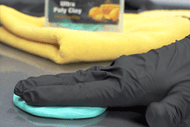Detail Clay and Your Cars Paint
1st Feb 2025 @ 3:11 PM
EVALUATING YOUR CAR'S PAINT FOR CLAY BAR TREATMENT
How do you know if your car needs a clay bar treatment? After thoroughly hand-washing your vehicle, feel the surface of your car's paint. Do you notice bumps or rough spots? These are contaminants damaging your car’s paint finish. Removing surface contaminants like road tar, acid rain spots, bug residue, paint overspray, brake dust, and hard water spots will improve the look and longevity of your car's paint. To enhance your sense of touch, use a sandwich bag or cellophane over your fingertips to detect imperfections.
Even after a meticulous car wash, many embedded contaminants remain in your car’s paint. Ever checked your foam wax applicator pad after waxing? The black residue you see is dirt trapped in the paint—and waxing over it seals it in.
WHAT IS A CLAY BAR AND HOW DOES IT WORK?
Clay bar detailing isn't a new concept. Professionals in paint and body shops have used it for years to remove paint overspray and other contaminants. It’s become increasingly popular in the car detailing industry and with everyday car owners.
Modern clay bars are made from fine polishing particles embedded in a soft, moldable material. Some manufacturers color-code clay bars by their coarseness to help identify the right option for specific needs.
While many clay bars claim to be "non-abrasive," they do contain fine abrasives that help lift contaminants without damaging the paint. These fine abrasives are gentle enough to avoid reducing gloss. In fact, using a clay bar correctly can enhance paint luster.
However, improper use of a clay bar, such as without adequate lubrication, can lead to paint damage. Always ensure you use a high-quality detailing spray or clay lubricant during the process to prevent scratches. Avoid lubricants with high alcohol content, as they can degrade the clay and strip wax protection.
DO YOU STILL NEED A PRE-WAX CLEANER AFTER CLAY?
Many car owners assume that using a clay bar eliminates the need for a pre-wax cleaner. While clay bars remove surface contaminants, they don’t replace pre-wax cleaners, which are essential for removing embedded dirt, old wax, and light stains.
Pre-wax cleaners are a combination of light polishing agents and cleaning solvents that restore gloss, eliminate minor imperfections, and prepare the surface for waxing. Regular use of a pre-wax cleaner can maintain your car's finish without reducing paint thickness.
For best results, use a pre-wax cleaner after claying and before applying wax. This ensures your car’s paint is clean and ready for a protective wax layer. Popular options include pure paint cleaners and cleaners with added paint protection.
TIPS FOR POLISHING AND PAINT CLEANING
When using pre-wax cleaners or polishing your car, always work in a shaded area to avoid direct sunlight. Polishes and cleaners work best on cool surfaces.
Focus on small sections at a time, about 2–4 square feet. Buff off residues as you go, and always follow the product manufacturer’s instructions for best results.
Choose the right applicator based on your paint condition:
- Foam applicator pads for new or well-maintained paint.
- Microfiber applicator pads for moderately oxidized finishes.
Apply a small amount of pre-wax cleaner—usually a 1-inch dab—to clean and polish effectively. Switch to a clean towel if residue becomes hard to remove. For optimal results, use a microfiber polishing towel for buffing.
After cleaning, your car’s paint should feel smooth, look streak-free, and be ready for waxing.

